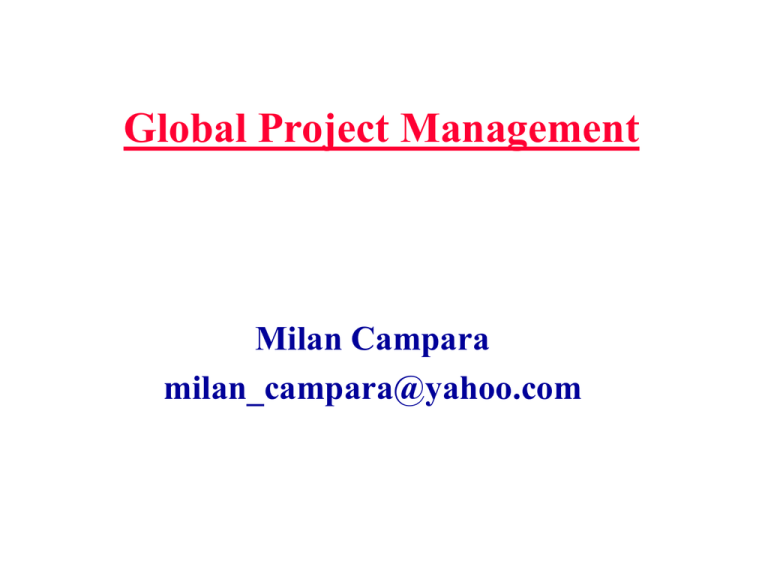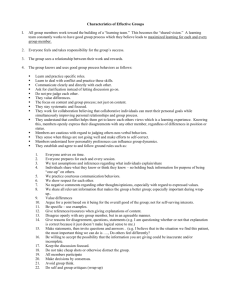Global Project Management
advertisement

Global Project Management Milan Campara milan_campara@yahoo.com Agenda 1. Business Case for Improvement 2. Project Management Process (PMP) 3. Management’s Role --Accountability, Accessibility, Leadership, Resources and Behaviors 4. Value Improving / Best Practices 5. Training and Certification 6. Challenges on Global Projects Business Case for Improvement Project Management Improves ROCE by Increasing Revenues, Decreasing Expenses, and Reducing Capital Employed REVENUE MINUS EXPENSES CAPITAL EMPLOYED = ROCE Project Management Leads to Pacesetter Performance (Cheaper, Faster, and More Predictable) Industry Average Facility Cost 1.25 Company X 30% Improvement Industry Average 1 Pacesetter Company 0.75 0.75 1 30% Improvement Execution Schedule 1.25 Project Management Process (PMP) A Process that Facilitates the Optimal Use of Resources (Dollars, People and Technology) Over the Life of an Asset / Project to Maximize Value. Desired Outcome • Select the Right Projects by Improving Decision Making • Improve Project Outcomes through Excellence in Execution of Decisions Project Management Vision High Decision Quality Consistent Success • Good Projects • Good Execution Random Success • Good Projects • Average Execution Mid Success Unlikely • Poor Projects • Poor Execution Low Random Success • Poor Projects • Good Execution Mid Execution Quality High Project Management Process (PMP) AFE PHASE 1 IDENTIFY Clearly Frame Goal Test for Strategic Fit Preliminary Overall Plan Preliminary Assessment ~1 % Engng. Class 1 Estimate 1 2 3 PHASE 2 PHASE 3 PHASE 4 SELECT DEVELOP EXECUTE Generate Alternatives Fully Define Scope Preliminary Development of Alternatives Develop Detailed Execution Plans Implement Execution Plan Develop Expected Value Identify Preferred Alternative Class 2 Est. Min. Changes Finalize Refine Estimate Operating Plan Submit Funding for Approval ~25 % Engng. Class 3 Est. (+/10 % Accuracy) Business Plan for Phase 5 Project Review 4 PHASE 5 5 OPERATE Operate Asset Monitor & Evaluate Performance Identify New Opportunities Management’s Role (1) Accountability—Business evaluation should be conducted 1 to 2 years after project completion and Project Sponsor should be held accountable for the financial outcome. Accessibility—Management should actively participate in gate keeping meetings at the end of each phase of the Project Management Process and communicate frequently with the project team. Management’s Role (2) Leadership—Management should establish clear expectations and objectives for the project team. Resources—Provide resources of right people and funding to support the project team. Behaviors—Demonstrate visible support and provide positive consequences for following Project Management Process, Best Practices and sharing Lessons Learned. Value Improving / Best Practices Value Improving / Best Practices are tools to improve project planning and execution. In conjunction with a structured Project Management Process they can optimize: – – – – Cost Schedule Performance Safety Value Improving / Best Practices Phase 1 Identify Phase 2 Select Phase 3 Develop Phase 4 Execute Phase 5 Operate • Decision & Risk Analysis • Project Execution Planning • Lessons Learned (Share) (Seek) • Value Improving Practices by IPA • Post Project Assessment • Peer Review • Pre-Funding Assessment $ EST Legend: D PFD $ EST D AFE = Appropriation for Expenditure D = Decision Point IPA = Independent Project Analysis, Inc. P&ID D AFE • Business Evaluation D PFD = Process Flow Diagram P&ID = Piping & Instrumentation Diagram D Project Execution Planning--Part A Defining the business goals that will determine project success Project Execution Planning--Part B Defining major phases, milestones, risks, organization, staffing and best practices to be used Project Execution Planning--Part C How time, cost, quality and resources will be managed Training • Decision & Risk Analysis (D&RA) • Leadership Roles & Behaviors (LR&B) • Project Management Skills from PMBOK --Project Integration Management --Project Scope Management --Project Time Management --Project Cost Management --Project Quality Management --Project Human Resource Management --Project Communications Management --Project Risk Management --Project Procurement Management Certification • All Decision Makers should be certified in: --Decision & Risk Analysis --Leadership Roles & Behaviors • All Project Professionals should be certified in: --Decision & Risk Analysis --Leadership Roles & Behaviors --PMBOK Areas Challenges on Global Projects • Communications --Different languages --Interpreters --Information management • Culture --What works in America vs. overseas • Logistics --Transportation --Different time zones --Rotational assignments Summary Structured Project Management Process, Management’s active role, application of Value Improving / Best Practices and Training / Certification can help achieve World-Class Project Performance: • • • • Faster Cheaper Better Safer




